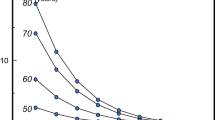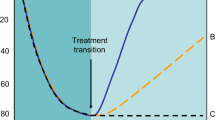Abstract
Clinical trials are used to determine the efficacy and safety of a medication prior to approval for commercial use and to influence the prescribing habits of clinicians. The lack of uniformity in the diagnostic thresholds used in clinical trials on osteoporosis makes it difficult to compare the results of these trials. The use of placebo, different anatomical sites, T-score cutoff points, and risk factors precludes any meaningful comparison being made between the outcomes of clinical trials. Finally, the lack of uniform reporting format makes it difficult to retrieve important information to compare one medication to another. Because the diagnostic thresholds used affect the outcomes of these trials, health care providers need to be aware of these criteria to determine whether the results of a particular clinical trial can be applied to a particular patient.
Similar content being viewed by others
Abbreviations
- BONE:
-
Ibandronate Osteoporosis Vertebral Fracture Trial in North America and Europe
- FIT:
-
Fracture Intervention Trial
- FREEDOM:
-
Fracture Reduction Evaluation of Denosumab in Osteoporosis Every 6 Months
- HIP:
-
Hip Intervention Program
- HORIZON:
-
Health Outcomes and Reduced Incidence with Zoledronic Therapy
- MORE:
-
Multiple Outcomes of Raloxifene Evaluation
- NHANES:
-
National Health and Nutrition Examination Survey
- PROOF:
-
Prevent Recurrence of Osteoporosis Fracture
- VERT:
-
Vertebral Efficacy with Risedronate Therapy
References
Papers of particular interest, published recently, have been highlighted as: • Of importance
• DeMets DL and Califf RM: A historical perspective on clinical trials innovation and leadership. JAMA 2011, 305(7):713–714. This article details the development of clinical research from its initial public health orientation to an industry-controlled business, often with little to no academic input. As this shift has occurred, trial methodologies have become increasingly influenced by imperatives to develop new approved products while meeting regulatory requirements. The authors call for renewed academic involvement in RCTs to adequately address public health needs in a profit-oriented system.
NIH Consensus Development Panel on Osteoporosis Prevention, Diagnosis, and Therapy. Osteoporosis prevention, diagnosis, and therapy. JAMA. 2001;285:785–95.
• Watts NB, Bilezikian JP, Camacho PM, et al.: American Association of Clinical Endocrinologists medical guidelines for clinical practice for the diagnosis and treatment of postmenopausal osteoporosis. Endocr Pract 2010, 16(Suppl 3). Detailed guidelines for the diagnosis and treatment of osteoporosis in clinical practice.
Cummings SR, Bates D, Black DM. Clinical use of bone densitometry: scientific review. JAMA. 2002;288:1889–97.
Incidence of vertebral fracture in Europe: results from the European Prospective Osteoporosis Study (EPOS). J Bone Miner Res 2002, 17:716–724.
O’Neill TW, Felsenberg D, Varlow J, et al. The prevalence of vertebral deformity in european men and women: the European Vertebral Osteoporosis Study. J Bone Miner Res. 1996;11:1010–8.
Liberman UA, Weiss SR, Brӧll J, et al. Effect of alendronate on bone mineral density and the incidence of fractures in postmenopausal osteoporosis. NEJM. 1995;333:1437–43.
Black DM, Palermo L, Nevitt MC, et al. Defining incident vertebral deformity: a prospective comparison of several approaches. J Bone Miner Res. 1999;14:90–101.
Lunt M, Ismail AA, Felsenberg D, et al. Defining incident vertebral deformities in population studies: a comparison of morphometric criteria. Osteoporos Int. 2002;13:809–15.
Harris ST, Watts NB, Genant HK, et al. Effects of risedronate treatment on Vertebral and nonvertebral fractures in women with postmenopausal osteoporosis: a randomized controlled trial. JAMA. 1999;282:1344–52.
Black DM, Cummings SR, Stone K, et al. A new approach to defining normal vertebral dimensions. J Bone Miner Res. 1991;6:883–92.
Melton LJ, Kan SH, Frye MA, et al. Epidemiology of vertebral fractures in women. Am J Epidemiol. 1989;129:1000–11.
Smith-Bindman R, Cummings SR, Steiger P, et al. A comparison of morphometric definitions of vertebral fracture. J Bone Miner Res. 1991;6:25–34.
Bonnick SL. Bone densitometry in clinical practice: application and interpretation. 2nd ed. Totowa: Humana; 2004.
Kanis JA, Melton III LJ, Christiansen C, et al. The diagnosis of osteoporosis. J Bone Miner Res. 1994;9:1137–41.
Marshall T, Johnell O, Wedel H. Meta-analysis of how well measures of bone mineral density predict occurrence of osteoporotic fractures. BMJ. 1996;312(7041):1254–9.
Klotzbuecher CM, Ross PD, Landsman PB, et al. Patients with prior fractures have an increased risk of future fractures: a summary of the literature and statistical synthesis. J Bone Miner Res. 2000;15:721–39.
Von Mϋhlen D, Lunde AV, Barrett-Connor E, et al. Evaluation of the simple calculated osteoporosis risk estimation (SCORE) in older Caucasian women: the Rancho Bernardo study. Osteoporos Int. 1999;10:79–84.
Ungar WJ, Josse R, Lee S, et al. The Canadian ScoreTM questionnaire. J Clin Densitom. 2000;3:269–80.
Cadarette SM, Jaglal SB, Kreiger N, et al. Development and validation of the osteoporosis risk assessment instrument to facilitate selection of women for bone densitometry. CMAJ. 2000;162:1289–94.
Black DM, Steinbuch M, Palermo L, et al. An assessment tool for predicting fracture risk in postmenopausal women. Osteoporos Int. 2001;12:519–28.
Cummings SR, Nevitt MC, Browner WS, et al. Risk factors for hip fracture in white women. N Engl J Med. 1995;332:767–73.
Geusens P, Hochberg MC, Van Der Voort DJM, et al. Performance of risk indices for identifying low bone density in postmenopausal women. Mayo Clin Proc. 2002;77:629–37.
Hochberg MC, Thompson DE, Ross PD. Validation of risk indices to identify postmenopausal women with an increased likelihood of osteoporosis. Osteoporos Int. 2002;13:S111.
Kanis JA, Johnell O, Oden A, et al. FRAX and the assessment of fracture probability in men and women from the UK. Osteoporos Int. 2008;19:385–97.
Chesnut CH, Skag A, Christiansen C, et al. Effects of oral ibandronate administered daily or intermittently on fracture risk in postmenopausal osteoporosis. J Bone Miner Res. 2004;19(8):1241–9.
Ettinger B, Black DM, Mitlak BH, et al. Reduction of vertebral fracture risk in postmenopausal women with osteoporosis treated with Raloxifene: results from a 3-year randomized clinical trial. JAMA. 1999;282(7):637–45.
Chesnut CH, Silverman S, Andriano K, et al. A randomized trial of nasal spray salmon calcitonin in postmenopausal women with established osteoporosis: the prevent recurrence of osteoporotic fractures study. Am J Med. 2000;109:267–76.
Neer RM, Arnaud CD, Zanchetta JR, et al. Effect of parathyroid hormone (1–34) on fractures and bone mineral density in postmenopausal women with osteoporosis. NEJM. 2001;344(19):1434–41.
Reid DM, Hosking D, Kendler D, et al. A comparison of the effect of alendronate and risedronate on bone mineral density in postmenopausal women with osteoporosis: 24-month results from FACTS-International. Int J Clin Pract. 2008;62(4):575–84.
Bonnick S, Saag KG, Kiel DP, et al. Comparison of weekly treatment of postmenopausal osteoporosis with alendronate versus risedronate over 2 years. J Clin Endocrinol Metab. 2006;91(7):2631–7.
Rosen CJ, Hochberg MC, Bonnick SL, et al. Treatment with once-weekly alendronate 70 mg compared with once-weekly risedronate 35 mg in women with postmenopausal osteoporosis: a randomized double-blind study. J Bone Miner Res. 2005;20(1):141–51.
Hosking D, Adami S, Felsenberg D, et al. Comparison of change in bone resorption and bone mineral density with once-weekly alendronate and daily risedronate: a randomized, placebo-controlled study. Curr Med Res Opin. 2003;19(5):383–94.
McClung MR, Geusens P, Miller PD, et al. Effect of risedronate on the risk of hip fracture in elderly women. Hip Intervention Program Study Group. NEJM. 2001;344(5):333–40.
Harris ST, Blumentals WA, Miller PD. Ibandronate and the risk of non-vertebral and clinical fractures in women with postmenopausal osteoporosis: results of a meta-analysis of phase III studies. Curr Med Res Opin. 2008;24(1):237–45.
Black DM, Delmas PD, Eastell R, et al. Once-yearly zoledronic acid for treatment of postmenopausal osteoporosis. NEJM. 2007;356(18):1809–22.
• Cummings SR, Martin JS, McClung MR, et al.: Denosumab for prevention of fractures in postmenopausal women with osteoporosis. NEJM 2009, 361:756–765. This article describes the FREEDOM trial, which randomly assigned osteoporotic women between the ages of 60 and 90 years to subcutaneous injections of 60 mg of denosumab or placebo twice yearly for a period of 3 years. The investigators concluded that this dosage of denosumab was associated with a reduction in the risk of vertebral, nonvertebral, and hip fractures in women with osteoporosis.
Acknowledgments
The authors thank Jennifer Culp and Lindy Russell for their assistance in the creation of this manuscript.
Disclosure
Conflicts of interest: R.C. Hamdy: has received honoraria from Eli Lilly, Amgen, Warner-Chilcott, and Novartis; and has received travel/accommodations expenses covered or reimbursed from Eli Lilly, Amgen, Warner-Chilcott, and Novartis; D.M. Price: none; M.M. Mottl: none.
Author information
Authors and Affiliations
Corresponding author
Rights and permissions
About this article
Cite this article
Hamdy, R.C., Price, D.M. & Mottl, M.M. Diagnostic Thresholds in Osteoporosis: How Are They Used in Clinical Trials?. Curr Osteoporos Rep 9, 160–166 (2011). https://doi.org/10.1007/s11914-011-0063-2
Published:
Issue Date:
DOI: https://doi.org/10.1007/s11914-011-0063-2




